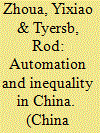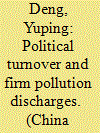|
|
|
Sort Order |
|
|
|
Items / Page
|
|
|
|
|
|
|
| Srl | Item |
| 1 |
ID:
170340


|
|
|
|
|
| Summary/Abstract |
In transitional economies, low wages imply sub-OECD yet growing labor shares of value added. China's rapid development has, however, seen a declining low-skill labor share and rising inequality. Here, a stylized model with three households and separable TFP and factor bias suggests a third of the decline in the low-skill share since 1994 is due to structural change and the rest mainly to skill-biased technical change. Expected future twists away from low-skill labor toward capital yield further inequality, moderated if strong TFP growth and population stability continue. But if the bias accompanies TFP shortfalls, worker displacement and rising inequality are in prospect.
|
|
|
|
|
|
|
|
|
|
|
|
|
|
|
|
| 2 |
ID:
170339


|
|
|
|
|
| Summary/Abstract |
China's ‘New Normal’ has been much discussed in recent years. An important aspect of the New Normal is the growth slowdown from levels of around 10% per annum to a more modest 6 or 7%. Not surprisingly, there has been widespread discussion of whether the slowdown is permanent or not and, in either case, what the sources of the slowdown are. However, much of this discussion has been based on informal analysis of the data rather than formal econometric results. We make a move in the direction of formal empirical analysis of this issue by estimating and simulating a vector autoregressive (VAR) model which distinguishes between demand, supply and foreign shocks as possible drivers of changes in economic growth. We analyse both two-variable (growth and inflation) and three-variable (foreign growth, domestic growth and inflation) VAR models and identify demand, supply and foreign shocks, using a modification of the Blanchard-Quah identification procedure. In the two-variable model we identify two shocks (demand and supply) and find that the slowdown since the GFC has been mainly supply-driven. This conclusion is not changed when a foreign growth variable is added to the model and a foreign shock is allowed for – we find that demand continues to be of relatively little importance, that the foreign shock also makes little contribution to explaining the long-run growth decline in China which continues to be driven by long-term supply factors. This conclusion is robust to a number of alternative formulations of the model. Thus, the growth slowdown may, indeed, be characterised as the ‘New Normal’.
|
|
|
|
|
|
|
|
|
|
|
|
|
|
|
|
| 3 |
ID:
170341


|
|
|
|
|
| Summary/Abstract |
This paper investigates the contributions of politically connected independent directors to shareholder value by examining stock price reactions to their mandatory resignations. Employing an event study, we find that, if a private firm loses its politically connected independent director due to mandatory resignation, its stock price drops 4.61% on average within ten trading days, compared with control firms. We observe that, compared with independent directors from academia, politically connected independent directors are absent from more board meetings and are reluctant to express dissenting opinions even if they attend meetings. So the negative stock price reaction cannot be mainly explained by the loss of supervisory functions after politically connected independent directors were forced to resign from positions. By employing DID estimation, we further find that the economic benefits obtained by private firms decrease after the mandatory resignation. The heterogeneity and robustness checks further confirm that private firms indeed were unable to get the same amount of economic benefits from the government as before, which provides a reasonable explanation for the negative stock price reaction after mandatory resignations of politically connected independent directors.
|
|
|
|
|
|
|
|
|
|
|
|
|
|
|
|
| 4 |
ID:
170348


|
|
|
|
|
| Summary/Abstract |
We estimate China urban household energy demand as part of a complete system of consumption demand so that it can be used in economy-wide models. This allows us to derive cross-price elasticities unlike studies which focus on one type of energy. We implement a two-stage approach and explicitly account for electricity, domestic fuels and transportation demand in the first stage and gasoline, coal, LPG and gas demand in the second stage. We find income inelastic demand for electricity and home energy, but the elasticity is higher than estimates in the rich countries. Demand for total transportation is income elastic. The price elasticity for electricity is estimated to be −0.5 and in the range of other estimates for China, and similar to long-run elasticities estimated for the U.S.
|
|
|
|
|
|
|
|
|
|
|
|
|
|
|
|
| 5 |
ID:
170350


|
|
|
|
|
| Summary/Abstract |
This paper uses a multi-country input-output model to simulate the impacts of the recent China-U.S. trade war. We first examine in detail the list of products subject to additional tariffs, and then use the model to estimate the economic impacts of the trade conflict. Based on the direct and indirect impacts on the energy sector of each country, we then extend the analysis to the issue of global energy demand. Our empirical results indicate that both China and the U.S. suffer from the conflict, although the impacts on China are greater Both countries experience a reduction in energy demand and a general economic slowdown. Although certain countries may benefit from the China-U.S. trade conflict in short-run, a general negative impact on the global economic prospects can affect all. Moreover, a short-term marginal impact on the global energy market is found, but as the consequence of long-term uncertainties and indirect economic impacts, further reductions of global energy demand are expected.
|
|
|
|
|
|
|
|
|
|
|
|
|
|
|
|
| 6 |
ID:
170344


|
|
|
|
|
| Summary/Abstract |
Using a unique data set of Chinese foreign direct investment (FDI) contracts from the 1980s and early 1990s, we explore those mechanisms of historical persistence resulting from China's unique colonial experience. Adopting difference-in-differences as well as difference-in-difference-in-differences analysis within conditional logit, we provide evidence that foreign investors favored locating FDI in Chinese cities in which their home country had a colony in the 19th century and that a human-capital channel best explains this persistent impact of colonial experience. While alternative explanations for long-term persistence are not consistent with the empirical findings, the results suggest that legal human capital inherited from colonial times affected economic decisions after 1978. Thus, we attempt to advance the literature on history's long-lasting influence by proposing one particular mechanism of persistence—memory of legal institutions, or inheritance of legal human capital.
|
|
|
|
|
|
|
|
|
|
|
|
|
|
|
|
| 7 |
ID:
170346


|
|
|
|
|
| Summary/Abstract |
Using data from the China Health and Nutrition Survey, this study analyses changes in bodyweight (body mass index and waist circumference) distributions between 1991 and 2011 among adults aged 20+ in China. To do so, we quantify the source and extent of temporal changes in bodyweight and then decompose the increase in obesity prevalence into two components: a rightward shift of the bodyweight distribution (mean growth) and a (re)distributional skewing. Our analysis reveals a clear rightward distributional shift combined with a leftward skewing. Although the relatively large size of this skewing in the first decade analysed reflects an increase in obesity inequality, this inequality growth subsides in the second decade. Nevertheless, over the entire 20-year period, obesity inequality increases significantly, especially among females, younger age groups, residents in rural and western provinces, and individuals with low socioeconomic status.
|
|
|
|
|
|
|
|
|
|
|
|
|
|
|
|
| 8 |
ID:
170349


|
|
|
|
|
| Summary/Abstract |
This paper aims to examine the relationship between political turnover and pollution discharges by listed firms in China. The empirical results show that political turnover is associated with more firm pollution discharges, particularly if the newly appointed officials are promoted locally or normally transferred. Furthermore, higher frequency of political turnover is linked with more pollution discharges. Lastly, our extended analysis illustrates that political connection is positively associated with firm pollution discharges and plays a moderating role in the relationship between political turnover and environmental performance.
|
|
|
|
|
|
|
|
|
|
|
|
|
|
|
|
| 9 |
ID:
170351


|
|
|
| 10 |
ID:
170345


|
|
|
|
|
| Summary/Abstract |
The reform of the shareholding system for collective assets (SSCA) has made clear the community members' rights to collective assets and their possessory rights, while changes in the residents' rights may alter their behaviors and community interests. In this study, the Difference-in-Differences estimation method is used to examine the impact of the SSCA reform on residents' participation in community governance. With residents' participation as the mediating factor, the mediating effect model is used to study the impact of the reform on community debts risk (CDR). When the household, community, and economic variables are controlled, the probability of residents in communities that have undergone reform being willing to participate in community governance is 5.6% higher than those in communities that have not. The results are significant at the 5% level. In terms of CDR, the SSCA reform has significantly reduced the debts–assets ratio by 7.9%. These findings have passed a series of robustness tests. This conclusion provides new ideas for promoting communities' democratic participation and debts risk management.
|
|
|
|
|
|
|
|
|
|
|
|
|
|
|
|
| 11 |
ID:
170342


|
|
|
|
|
| Summary/Abstract |
One critical factor that affects China's achievement of its peak emission by 2030 is total electricity demand. The aim of this study is to examine regional disparity in electricity consumption in China. The analysis is based on a panel database which is compiled at the provincial level. A distributional dynamics approach is then employed to reveal the trend and movement of each province within the distributions in different regional groupings. The mobility probability plot (MPP) is also employed to provide detailed information on the probability of change in electricity consumption. The results demonstrate significant divergence presents across provinces, over time and within different regional groups. The results can pinpoint the transition mechanism within each region so that appropriate energy policy can be formulated to accommodate future demand in electricity for different regions in China. The results suggest that regional specific energy efficiency policy is needed.
|
|
|
|
|
|
|
|
|
|
|
|
|
|
|
|
| 12 |
ID:
170343


|
|
|
|
|
| Summary/Abstract |
This paper uses patent data from the U.S. Patent and Trademark Office to investigate the association between inventor collaboration and joint assignee ownership, both domestic and international, and patent quality as measured by the number of claims and citations associated with a patent. Specifically, we compare the quality implications of research collaboration and joint patent ownership for the quality of U.S. and Chinese patents. Overall, we find that domestic inventor collaboration is associated with higher quality results for U.S. patents than Chinese patents. However, for China, international collaboration is associated with more positive quality outcomes; for U.S. patents, international collaboration implies lower quality than that associated with domestic U.S. collaboration. Part of this disparity is due to substantially different quality outcomes associated with joint U.S.-Chinese patents – quality gains for China and quality reductions for the U.S. We also investigate the quality implications of different organization-centered research, including dyadic and triadic collaborations, for patent quality as well as the quality implications of various assignee-inventor relationships, operating through incentive and scale effects. While most firms, particularly those in the U.S., appear to exploit advantages of fewer owner-assignees coordinating the scale benefits of more inventors, universities and research institutes in China appear to rely less on coordination-scale effects and more on the incentive effects associated with assigning patent ownership to inventors.
|
|
|
|
|
|
|
|
|
|
|
|
|
|
|
|
| 13 |
ID:
170347


|
|
|
|
|
| Summary/Abstract |
To manage the peak load by demand response, time-of-use (TOU) pricing with hourly and seasonal adjustments has been applied in industrial and commercial sectors in Shanghai. However, the requirement of continuous production and exogenous output level might be a serious barrier for responding to TOU price, as these are different across industrial sectors, firm scale or even seasons. Thus, the extent to which heterogeneous firms respond to price signals is still ambiguous and worthy of exploration. Based on a regression discontinuity approach, we disentangle the firm-level effects of TOU pricing for industrial and commercial firms. While the overall result shows a nonsignificant average response to TOU pricing, the firm-level analysis concerning individual heterogeneity indicates that smaller firms are much more sensitive to TOU pricing than larger firms. Moreover, this effect is much more significant in the commercial sector. This study expands understanding of the heterogeneous effects of TOU pricing with consideration of firm-level information and fills the gap between different estimation results from the previous literature. The results also indicate a price policy failure and unbalanced effects on industrial and commercial firms.
|
|
|
|
|
|
|
|
|
|
|
|
|
|
|
|
|
|
|
|
|